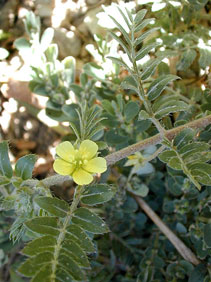PUNCTURE VINE
|
 |
| File Size: 100 KB |
|
|
|
Tribulus terrestris L.
|
| Mitchell County, Kansas |
| Annual |
| Height: Prostrate |
| Family: Zygophyllaceae - Caltrop Family |
| Flowering Period: July, August, September |
|
| Also Called: | | Goat head. | | Stems: | | Prostrate, branched, radiating to 5 feet from top of taproot, hairy, becoming nearly glabrous. | | Leaves: | | Opposite, short-stalked, 1/2 to 2 inches long, even-pinnately compound; leaflets 6-14, oblong to narrowly ovate, to 1/2 inch long, less than 1/6 inch wide, sparsely silky-hairy; margins entire; tips pointed or blunt. | | Inflorescences: | | Solitary flowers, on short stalks in leaf axils. | | Flowers: | | About 1/2 inch wide; sepals 5, ovate, pubescent; petals 5, to 1/4 inch long, yellow, drying whitish; tips rounded or lobed; stamens 10. | | Fruits: | | 5-segmented, 1/2 inch in diameter, hard, dry, each segment with 2-4 stout spines to 1/3 inch long; seeds 2-5 per segment, small. | | Habitat: | | Sandy or gravelly disturbed sites, waste areas, roadsides, lawns, and alleys. | | Distribution: | | Throughout Kansas. | | Origin: | | It was introduced from southern Europe but now is widespread over much of the U.S. First recorded in Kansas in the late 1800s, puncture vine spread rapidly along railroads and roadways. | | Comments: | | Puncture vine often forms dense mats. The sharp, tack-like spines can puncture bicycle tires and cause injuries to the feet of animals and humans. Puncture vine is difficult to eradicate. The seeds can remain dormant in the soil for 4-5 years. |
|
| Puncture vine |  | | 62 KB | | Russell County, Kansas |
| | Puncture vine |  | | 168 KB | | Mitchell County, Kansas |
| | Puncture vine fruit |  | | 94 KB | | Konza Prairie, Riley County, Kansas |
| | Puncture vine leaves |  | | 98 KB | | Konza Prairie, Riley County, Kansas |
| | Puncture vine flower |  | | 98 KB | | Konza Prairie, Riley County, Kansas |
| | Puncture vine burs |  | | 152 KB | | Russell County, Kansas |
| | | | |
|
|
|
|
|
|